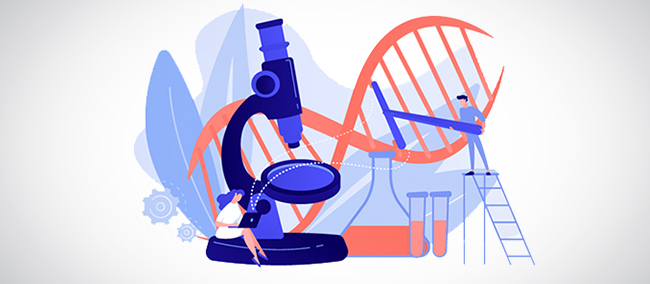
CRISPR continues to make headlines as a powerful genomic editing tool. With a Nobel Prize, CRISPR-based COVID-19 diagnostics, and several successful clinical trials in the last year alone, the breakthroughs just keep coming. Now scientists are taking CRISPR to another level – the epigenome.
In a recent paper published in Cell, a team of researchers led by the Whitehead Institute has discovered a unique way to use CRISPR to precisely control gene expression. The new tool is called “CRISPRoff”, and it makes it possible for any gene in a human cell to be turned off without altering the DNA sequence.
Traditional CRISPR methods involve editing the DNA using a protein found in bacterial immune systems along with single guided RNA to target the specific gene of interest. The protein, known as Cas9, acts as a molecular pair of scissors that cuts or deletes part of the genome. This alteration is permanent and relies on the body’s own “in-house” cellular repair mechanisms to keep the procedure limited to just the specific change. However, potential off-target activities could alter the function of otherwise intact genes, which is a downside of using CRISPR.
“Though genetic and cellular therapies are the future of medicine, there are potential safety concerns around permanently changing the genome, which is why we’re trying to come up with other ways to use CRISPR to treat disease,” said Luke Gilbert, PhD, assistant professor at the University of California San Francisco and co-senior author of the publication.
CRISPRoff uses the same homing device part of the original CRISPR but holds back the DNA cutting enzyme function. It can still target the gene, but it does not delete it. Instead, it acts on the epigenome, or the proteins and chemical compounds attached to DNA at the site of the gene.
The epigenome refers to the collection of all the epigenetic marks on the DNA in a particular cell. These marks affect the way genes are expressed and differ across tissue types, unlike DNA which is the same in every cell. The epigenome is also dynamic in nature, and alterations can be passed down through generations. Epigenetic mechanisms like DNA methylation and histone modifications play critical roles in the development of many diseases and conditions.
For this new tool, the scientists targeted DNA methylation in particular because it can repress gene activity. The process of DNA methylation occurs when a small chemical tag, known as a methyl group, gets attached to DNA. While it can occur naturally in a cell, the CRISPRoff technique lets researchers dispense the methylation compound directly to a site on the DNA that will then silence the adjacent genes.
To construct the epigenetic editor that stimulates the DNA methylation effects, the team developed a tiny protein mechanism that uses a single guide RNA (sgRNA) to append a methyl group to certain spots on the DNA strand. Since this method does not modify the genetic sequence, the process is reversible. The researchers can use enzymes in the same way to remove the methyl group, and they referred to this technique as “CRISPRon”.
“Now we have a simple tool that can silence the vast majority of genes,” said former UCSF faculty member and co-senior author Jonathan Weissman, PhD. “We can do this for multiple genes at the same time without any DNA damage, and in a way that can be reversed. It’s a great tool for controlling gene expression.”
During their testing, the team was surprised to find that their method worked on a large majority of genes in the human genome, including regions that do not code for protein yet control gene expression. More astounding, CRISPRoff silenced genes in areas that did not have a high concentration of CG sequences, known as CpG islands.
Prior to this work, it has been believed that methylation can only silence genes at CpG sites. “Our work clearly shows that you don’t require a CpG island to turn genes off by methylation. That, to me, was a major surprise, ” said Gilbert.
To investigate the practicality of CRISPRoff for therapeutics, the researchers tested it in induced pluripotent stem cells, which are commonly used for disease modeling. They found that when a gene was silenced in a treated cell, it remained off in descendant cells as it divided. This tested true even for maturing stem cells that normally undergo significant epigenomic modification during transition.
In fact, CRISPRoff-targeted genes continued to be silenced in about 90% of the cells that made this transition, proving that the cells kept an epigenetic memory of the modification. The results indicate a lasting effect occurs from just one application with CRISPRoff, making it ideal for treating rare genetic diseases and certain types of cancer linked to genetic mutations.
The authors are also excited about the potential uses that this technique will have, not only in therapeutics but for research as well. They see it as a great tool for exploring the inner workings of the genome. As stated in their paper, “The broad ability of CRISPRoff to initiate heritable gene silencing even outside of CGIs expands the canonical model of methylation-based silencing and enables diverse applications including genome-wide screens, multiplexed cell engineering, enhancer silencing, and mechanistic exploration of epigenetic inheritance.”
Further research is necessary to understand the full potential that CRISPRoff presents for therapeutics. The expectation is that this new epigenetic-type editing tool and similar technologies will be part of the next generation of medicine. More immediately, this new tool will allow researchers to further their understanding of the mechanisms involved in heritability – primarily the mystery of epigenetic inheritance.
Source: James K. Nunez, et al. (2021). Genome-wide programmable transcriptional memory by CRISPR-based epigenome editing. Cell.
Reference: Jason Alvarez. New CRISPR Technology Offers Unrivaled Control of Epigenetic Inheritance. University of California San Francisco, April 15, 2021.

